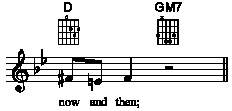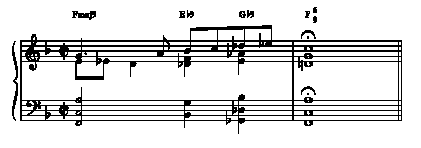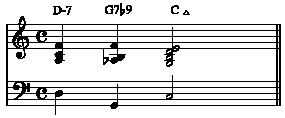24. SHORT-FORM SCORING
(Table 24)
24.1. Short-form scoring is a braille method of notating chord symbols composed of letters, numbers, accidentals and other print symbols. This system uses literary braille or common music signs wherever possible rather than a system of special braille characters. The chord symbols are often found in popular and folk music in lieu of, or in addition to, an accompaniment part. There are several combinations of words, chords, and music. Occasionally the chords are shown with words alone; sometimes they appear with keyboard music only, or with a melody only, but in a large majority of cases they occur with words and a melody. It is for all these types of print scores that the method described in Section 24 is designed. Diagrams often accompany the chord symbols but are not included in the transcription. If requested, however, the chord symbols used in a particular piece can be listed separately, according to Par. 23.30 and Example 23.30-1.
24.2. The chord symbols are brailled in a "facsimile" method, i.e., in general, symbols are brailled horizontally, unspaced, in the exact order shown in print, with exact lettering, capitalization, etc. Particular directions and exceptions to this general rule are given in the following six paragraphs and are illustrated in braille and print in Table 24.
24.3. All literary symbols are transcribed in literary braille. Contractions and letter signs are not employed. Capitalization follows the print. All periods are omitted.
24.4. Music signs are used for accidentals and are brailled in the order shown in the print copy.
24.5. Signs for minus (-), dots 3-6, and plus (+), dots 346, are brailled in the order shown in the print copy.
24.6. A "dropped" d is used for the small circle, and a "dropped" d followed by a dot 3 for the circle with a slash through it. They represent respectively, diminished and half-diminished. However, if the print shows the abbreviation "dim", it is written out as shown.
24.7. (11-97) The number sign is brailled before every number. In a vertical arrangement of numbers, the lower number is brailled first; in a horizontal arrangement, the print copy is followed. See Example 24.14-1.
24.8. A slash line between symbols (as in G/D) is transcribed as dots 34, and indicates that the letter following the line represents the bass note of the chord. This braille procedure is also used to indicate the bass note when the information is written out in full. (See Example 24.13.2-1.)
24.9. Where words, chords and a melody are present, they are combined in an expanded line-by-line format consisting of a three line parallel. Words are placed on the first line, corresponding chords on the second line, and the corresponding melody on the third line. (If a keyboard part is present, it is transcribed separately, bar-over-bar.)
24.10. The word line always starts at the margin, either with a word, a syllable, or a measure number. (Numbers, with a prefix, are shown occasionally at the discretion of the transcriber, governed mainly by the phrasing. It is undesirable to number every parallel.) Placement of chords on the second line is dictated by their relationship to the words. The melody line always starts in the third cell. A runover line, commencing in the fifth cell, may be used to extend the melody line on occasion, but not the words.
24.11. (11-97) The abnormal appearance and spacing of some words is made necessary by the amount of space required for the correct placement of each succeeding chord symbol. Where the space required by the symbols necessitates a separation of four or more cells between words or syllable divisions, a series of dots 36 is inserted in the word line, with a blank space before and after the series.
24.12. Chord symbols are placed in relation to the WORDS, not to the melody, and the placement of the initial capital sign of each chord (or a hyphen preceding it) is the determining factor as to whether the chord is played with, before, during, or after the word or syllable is sounded. All punctuation marks, including apostrophes, in the word line are disregarded with respect to alignment. Usually a space is not necessary between the chord symbols, since the capital sign or hyphen prefix indicates the beginning of a new chord. However, where more than one capital letter appears in a chord notation (as in GnoD, or D/A), there should be a space between such chord notation and the next.
24.13. Placement of the chord symbols is made according to the following directions:
24.13.1. (11-97) Where the chord is sounded with the related word or syllable, the initial capital sign of the chord is vertically aligned with the initial character of the syllable (whether a capital sign or letter).
Example 24.13.1-1.
%#D4
,STARS WERE SHINING
,G ,BM ,C ,D
.::::
IN THE SKY ABOVE1
,C ,CM
.EDDE?V<K

24.13.2. Where the chord is sounded before the word or syllable, the initial capital sign of the chord is placed two spaces to the left of the initial character of the word (as with the second chord in the example below).
Example 24.13.2-1.
<<<#D4
,WHY --- DO YOU AND ,I GO
,A<,M#G,F#G/,A ,B<
"( XGGGJH"
ON PRE- TENDING8
,G#G/,B ,CM
"GH G'&@CP'<K

24.13.3. However, where a chord would precede the first word on a line, (preventing this line from starting at the margin, as required) an adjustment must be made. Usually the preceding parallel is shortened to the extent needed in order to allow the new word line to start in the first cell. No adjustment is necessary, of course, if the line commences with a measure number, as in the next example. (A number should not be inserted arbitrarily for this purpose, however, divisions should generally be made on a musical basis.)
Example 24.13.3-1.
#D4
#I NOW IT'S JUST A MEMORY1
,E#G ,AM
U"FF%GF VIJS<K

24.13.4. Where the chord is sounded during the syllable, the alignment factor is a hyphen. The hyphen, followed without a space by the capital sign of the chord, is vertically aligned with the first character of the syllable.
Example 24.13.4-1.
%#D4
,WhO KNOWS ---- IF WE WILL MEET
,AM#G,AM#G/,D ,G -,G/,F%
"$$U VX((@CH!(@CH"
AGAIN8
-,EM
.Z)@C T<K

24.13.5. Where a chord change occurs with, and others occur during, the same syllable (or where two or more changes take place during the same syllable), the hyphen prefix of the second chord (or any additional ones) cannot be placed under the beginning of the affected syllable. This causes no problem for the reader, however, because the prefix continues to act as a "during" indicator for the chord that follows it.
Example 24.13.5-1.
<<<.C
,FAR1 FAR AWAY4
,CM ,G#G ,CM-,FM-,CM
"P'G'Z Y@C N<K

24.13.6. The first word or syllable that follows a chord which is preceded by a hyphen must be placed at least two spaces to the right of the hyphen so that the new word or syllable cannot become aligned or associated with the previous chord. This may necessitate the extension of a syllable with a hyphen in the word line, for example, where a chord is struck during a one-cell syllable or contraction that occurs at the beginning of, or in the middle of, a word. (A space is not left after the word hyphen unless space is needed for additional chord change.)
Example 24.13.6-1.
#D4
O-PEN YOUR HEARTS TO
-,CM
"\@C2H<FG\[<K

24.13.7. Where the chord is sounded after the syllable or word has been released, the initial capital sign of the chord is placed one space to the right of the final letter. (See Example 24.13.7-1.) If previous chordal material already extends beyond the word, the chord follows this material, without space. (See Example 23.13.7-2.)
Example 24.13.7-1.
<<.C
NOW AND THEN2
,D ,G,M#G
%"G*F]U<K

Example 24.13.7-2.
<<.C
LOVE A- -- WAY4
,DM ,D<4#G,CM#G,F#G
"S'\T'V<K

24.14. Where words and chords appear alone, and no music is present, a two-line parallel is used, with the chords aligned beneath the related syllables and words in the stated manner.
Example 24.14-1.
,AND ,I'LL TRY TO BE SMILING4
,G#G ,DM#G,G#G,F ,EM ,DM
G7 Dm7 G7 F Em Dm
And I'll try to be smiling.
24.15. If more than one verse is given with the same music (or the same with slight variations), only the first one is written with the chords and melody. Additional verses are written at the end of the piece in a two-line parallel consisting of words and chords only. Minor variations in the melody that apply to verses at the end of the piece may be shown as an in-accord in the music line of the first verse, labelled with the verse number (in the manner of the music line of Example 22.21-1). If verse numbers and measure numbers appear simultaneously, the verse number is placed one space beyond the measure number. Measure numbers are not shown in the additional verses written.
24.15.1. Where a second verse has only a few words different from the first verse, the variation may be shown within the first verse provided the original and the variation can be shown in one braille line. The indication of verse number, and the variation, are enclosed in word signs. The chords are shown under each version, but the melody is written only once.
Example 24.15.1-1.
<<<.C
,WILL YOU WAIT FOR >V#B COME WITH>
,FM#G ,B<#G ,B<#G
"JJJ("
ME8
-,E<,M#G
")@C T<K

24.15.2. If there are a number of word and melodic variations present, however, each verse is brailled separately, in the usual three-line parallel.
24.16. When a vocal arrangement contains melody only (no piano accompaniment part) and notes are included in the melody for which there are no words, these notes should be transcribed, and enclosed in music parentheses.
24.17. In a piece with very few chord indications, it is possible to have an entire parallel with no chord changes shown. In that case, the last chord in effect in the previous parallel is repeated (within word signs) at the beginning of the chord line, vertically aligned with the first word. If no words occur in a parallel, "no words" is placed at the margin of the word line, and the appropriate number of rests is brailled in the melody line.
24.18. Chords at the beginning of a song may be handled according to the following example:
Example 24.18-1.
#D%#D4
#J ------------------------- ,THE
,B,EMAJ#G,A#F/,E ,EMAJYG,A#F
VU MMM UV%"H<K

24.19. If chord symbols accompany a keyboard transcription that has no words, the chord symbols constitute the bottom line of a three-line parallel. The first chord in each measure is aligned with the music at the beginning of the measure, but no attempt is made to align chords with beats within a measure.
Example 24.19-1.
<_C
.>"\'IJD<E<F<>"F<F:]<+<[# .Y#*3<L<K'
_>^Q9+W0<\<9+ ''''''''''' ^=9+<L<K'
,FMAJ#I,E<#I,G<#I ,F#I#F

24.20. Chord symbols with melody alone are treated similarly to a keyboard transcription. (See Example 24.19-1 above.)
24.21. (11-97) Some print symbols, such as the small circle (diminished) and small circle with a line through it (half-diminished), have standard meanings. Others have different meanings in different publications; e.g. the small triangle and the italicized 7 have been used to indicate major sevenths and also diminished sevenths according to different composers. All explanatory material will, of course, be included in the transcription. In examples (a) and (b) below, the triangle and the "italicized" (unusual) 7 both indicate major seventh chords. In both cases, the meaning of the chord symbol was explained at the beginning of the print publication. The prefix for the right hand part when intervals read up is used in example (a). In example (b), the "notes" are merely an indication of rhythm for a jazz guitarist.
Example 24.21-1.
(a)
.C
.>>_[+0<[/0" R+90<K
_> _:" ^\ _N<K
,D-#G,G#G<#I,C0

(b)
#AB8
"JJJJJJ" W'V'<K
,GM ,C#G ,F.#G

24.22. Oblique lines used to indicate rhythmic strumming are occasionally shown with a melody without words. Strumming signs are represented by dots 3-4, and are placed on a separate line directly below the notes to which they apply. If chord symbols also appear, they are placed on the bottom line of a three-line parallel, aligned with the beginning of the measure in which they occur.
Example 24.22-1.
#C4
#J "DE FH@C\DE FH@C\.DE FH@C\FE ?[<K
/ // / / / / // //
,C ,C#G ,F

24.23. The following "Transcriber's Note" should be included with any transcription of songs containing chord symbols and words.
"The chord symbols in this song relate to the words. The position of the initial capital sign in each chord symbol determines whether the chord is played before, with, or after the related word or syllable. If the chord is sounded before, its initial capital sign is placed two spaces to the left of the initial character of the syllable; if with, its capital is vertically aligned with the syllable; and if after, its initial capital is placed one space to the right of the final character of the word. Punctuation marks in the word line have no bearing on the relative position of the initial sign of a chord.
"If the chord is sounded during a syllable, the chord's initial capital sign is preceded by a hyphen. The hyphen prefix serves as the alignment factor, and is vertically aligned with the first character of the syllable. (If this alignment is prevented because a preceding chord is related to the same syllable, the hyphen prefix follows said chord, immediately.)
"The abnormal appearance and spacing of some words is made necessary by the amount of space required for the correct placement of each succeeding chord symbol."
24.23.1. Special signs used in transcribing a chord, such as a plus, minus, small circle, slash line, etc., should be listed and identified for the reader.













